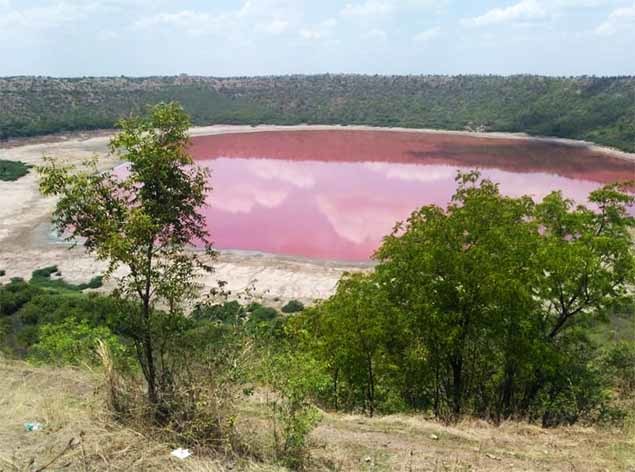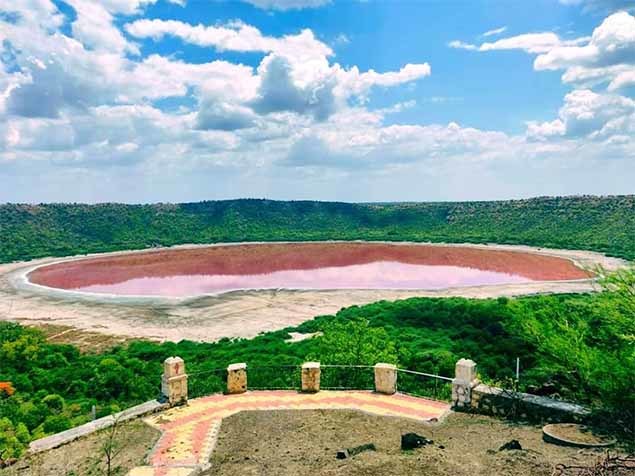Lonar Crater Sanctuary Lake
This is a collection of articles archived for the excellence of their content. |
The lake
2020 June: lake turns pink
Vijay Pinjarkar, June 11, 2020: The Times of India

From: Vijay Pinjarkar, June 11, 2020: The Times of India

From: Vijay Pinjarkar, June 11, 2020: The Times of India

From: Vijay Pinjarkar, June 11, 2020: The Times of India
A 56,000-year-old lake in Maharashtra has turned pink. Over the past few days, the Lonar Crater Sanctuary Lake in Buldhana district has taken on a pinkish-reddish hue, and naturally it's become a hot topic of discussion among the forest department, scientists, nature lovers, and on social media.
Situated inside the Deccan Plateau that's a massive plain of basalt rock, the 77.69-hectare lake is part of the Lonar sanctuary that totals 3.66sqkm. Located around 500km from Mumbai, it is a popular tourist hub and and also attracts scientists from all over the world. It is famous for being the world’s largest basaltic impact crater, formed when a meteorite/asteroid hit Earth some 56,000 years ago. Two similar crater lakes are located in Dhala and Ramgarh in Madhya Pradesh and Rajasthan, respectively, but both are relatively unknown.
MN Khairnar, deputy conservator of forests (wildlife), Akola, said, “We are observing the phenomenon to such an extent for the first time. We will collect samples of the lake water for testing to find the reason behind the occurrence. These samples will be sent to Neeri, Nagpur, and Agarkar Research Institute, Pune.” Some experts have noted that Lonar Lake's highly alkaline, which means high concentration of carbonate salts, as well as saline chemistry support the growth of a family of bacteria known as Halobacteriaceae. These organisms thrive in highly saline conditions, producing a red pigment that absorbs sunlight and converts it into energy. When they proliferate in large amounts, the water body that they are in may take on a reddish hue.
Additional principal chief conservator of forests & Melghat Tiger Reserve (MTR) field director MS Reddy said a similar phenomenon takes place at the Umria lake in Iran, which is well documented. Scientists studying that lake have concluded that during dry seasons, the water level goes down, thus increasing salinity of water. The increased salinity and warm water becomes a breeding ground for Dunaliella algae that usually appears green. However, in an environment of high salinity and increased light intensity, it can turn red through the production of protective cartenoids – the same pigment found in carrots.
“This algae, under such circumstance, turns red in colour. The halobacteria also uses a red pigment to absorb sunlight and convert it to energy. This also turns the water red,” Reddy said. “With monsoon, the water level will increase and water temperatures will go down turning the lake water back to its normal coloration,” he added.
The Lonar lake, which is a notified national geo-heritage monument, has saline water with pH of 10.5, Gajanan Kharat, member of the Lonar lake conservation and development committee, said. "There are algae in the water body. The salinity and algae can be responsible for this change." "There is no oxygen below one metre of the lake's water surface. There is an example of a lake in Iran, where water becomes reddish due to increase in salinity," he noted.
Harish Malpani, head, department of microbiology, RLT College of Science, Akola, however, said the phenomenon needs to be probed further. “Halobacteria is not harmful to humans but its presence needs to be established. Sudden change in colour of water is strange. It might be because of microbial activities or could even be human interference. Research should be conducted before making any comments,” he said. According to Arun Mapari, an activist fighting to save Lonar, “the reason of its unique colour is still not fully understood by scientists, though most suspect it has to do something with the presence of Dunaliella salina microalgae. Dunaliella produces carotenoids, a pigment found in carrots as well. But presence of halophilic bacteria in the salt crusts could be another explanation.” He added “A reaction between the salt and sodium bicarbonate found in the water may cause it as well.”
World's largest basaltic impact crater
- The water of Lonar Lake is both saline and alkaline in nature, which makes it unique
- It is what is called a 'soda lake'. Its unusual geochemistry enables the growth of specific types of microorganisms, some of which are not found anywhere else
- This lake was created due to a meteorite impact and the craters that formed are among the most interesting geological structures on the planet
- The lake is located in the world's only high velocity, impact crater in basaltic rock. Scientists say the crater was formed when a meteorite or asteroid hit the area at a speed of 90,000 kmph
- The diameter of the crater on which the lake sits is 1.8km, while the lake's diameter is 1.2km